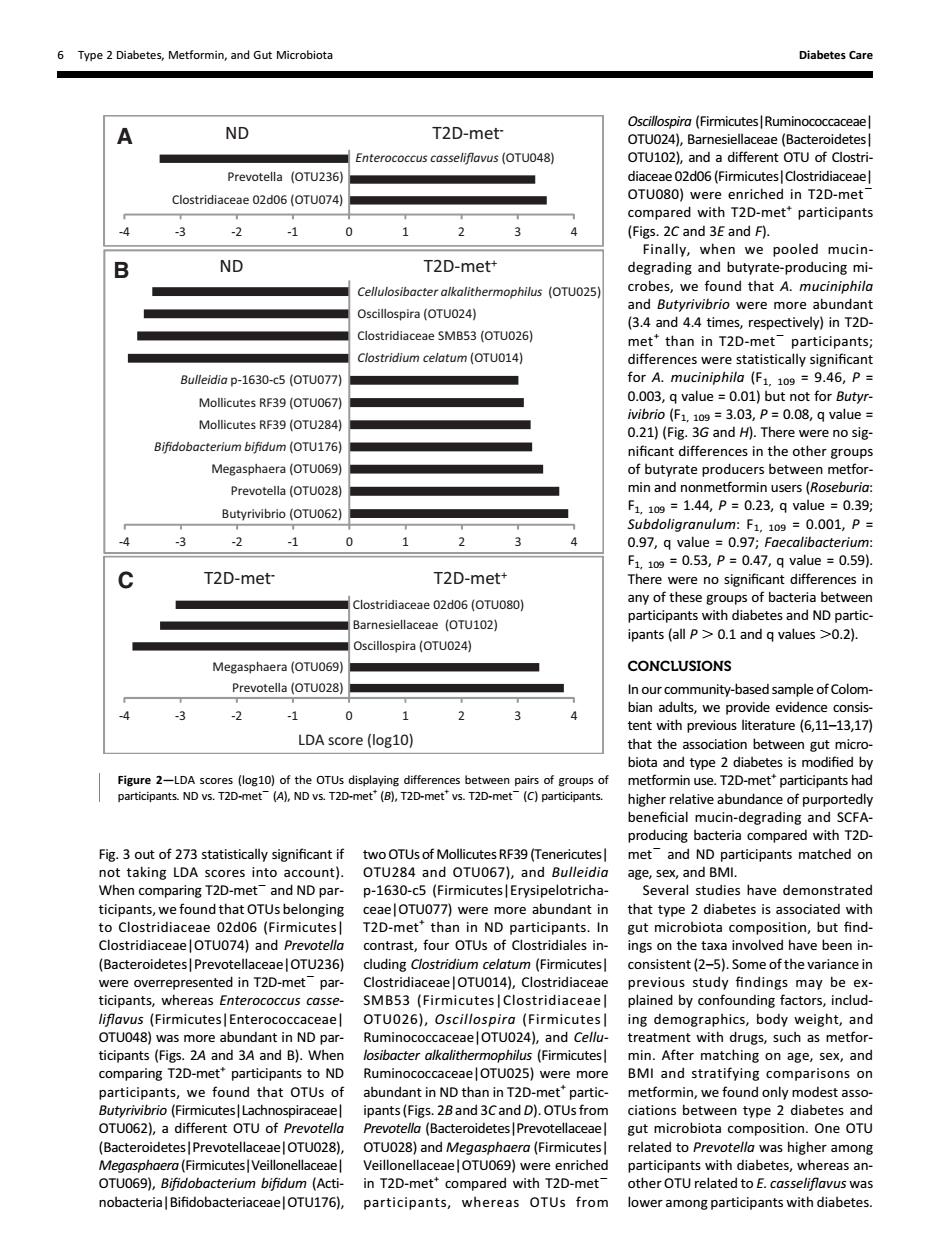正在加载图片...

6 Type 2 Diabetes,Metformin,and Gut Microbiota Diabetes Care A ND T2D-met OTUO2).Baresiellaceae(Bacteroidetes Enterococcus casselifiavus(OTU048 Prevotella (OTU236) OTU080)were enriched in T2D-met compared with T2D-met*participants 3 2 0 1 2 3 and F ND T2D-met' obe we ound that A. (3.4 and 44 times.respectively)in T2D. met*than in T2D-met participants tridium celatum (OTU14 Bulleidia p-1630-c5(OTUO7 Mollicutes RF39(OTUO6 00o,0si0eoh0ofbunotur Mollicutes RF39 (OTU284 2 Bifidobacterium bifidum (OTU176 tdiffer Megasphaera(OTU069 otbutyraiteproducesbeteenRC Prevotella (OTU028) n and nonme Butyrivibrio (OTU062) =0001.p -3 -2 0 3 C T2D-met T2D-met+ any of these groups of bacteria betweer Clostridia tes and ND p nd q values>0.2 Me CONCLUSIONS Prevotel a(0u028 mmnity-ba ple of Colom .3 .1 0 3 tent with previous literature (6.11-13.17 LDA score(log10) that the a association between gut micro of -(C)par higher relative abundance of purportedly netcidlmucin.degradingandSCfA 3 out of 273 statistically significant if two OTUs of Molli metndND participants matchedon age,sex,and BMI. hen co that OTand ND eve es hav o Clostridiac 02d06 (Firmicutes T2D-met'than i ND participants.In tMCobiaacompcsion,buiimd lostridiaceae OTU074)and Prev contras fou OTUs idiales in ngs on the taxa involved have been in e cipants,whereas Enterococcus c 556 SMB53(Firmicutes|Clostridiaceael plained by confounding factors,includ- Ent 0TU026 body weight,and ints (Figs.2A and 3A and B).W After matching on age sex and articipa ts t Ruminoc aelOTU025)were more s on we s(E OTU062).a different OTU of Pre Prevotel a(Bacteroide t microbiota composition.One OTU 02 8)and M was higher among OTU)bifidum (Acti in T2D-met*compared with T2D- other otu related to f casseliflayus was nobacterial BifidobacteriaceaelOTU176). participants,whereas OTUs from lower among participants with diabetes. Fig. 3 out of 273 statistically significant if not taking LDA scores into account). When comparing T2D-met2 and ND participants, we found that OTUs belonging to Clostridiaceae 02d06 (Firmicutes| Clostridiaceae|OTU074) and Prevotella (Bacteroidetes|Prevotellaceae|OTU236) were overrepresented in T2D-met2 participants, whereas Enterococcus casseliflavus (Firmicutes|Enterococcaceae| OTU048) was more abundant in ND participants (Figs. 2A and 3A and B). When comparing T2D-met+ participants to ND participants, we found that OTUs of Butyrivibrio (Firmicutes|Lachnospiraceae| OTU062), a different OTU of Prevotella (Bacteroidetes|Prevotellaceae|OTU028), Megasphaera (Firmicutes|Veillonellaceae| OTU069), Bifidobacterium bifidum (Actinobacteria|Bifidobacteriaceae|OTU176), two OTUs ofMollicutes RF39 (Tenericutes| OTU284 and OTU067), and Bulleidia p-1630-c5 (Firmicutes|Erysipelotrichaceae|OTU077) were more abundant in T2D-met+ than in ND participants. In contrast, four OTUs of Clostridiales including Clostridium celatum (Firmicutes| Clostridiaceae|OTU014), Clostridiaceae SMB53 (Firmicutes|Clostridiaceae| OTU026), Oscillospira (Firmicutes| Ruminococcaceae|OTU024), and Cellulosibacter alkalithermophilus (Firmicutes| Ruminococcaceae|OTU025) were more abundant in ND than in T2D-met+ participants (Figs. 2B and 3C and D). OTUs from Prevotella (Bacteroidetes|Prevotellaceae| OTU028) and Megasphaera (Firmicutes| Veillonellaceae|OTU069) were enriched in T2D-met+ compared with T2D-met2 participants, whereas OTUs from Oscillospira (Firmicutes|Ruminococcaceae| OTU024), Barnesiellaceae (Bacteroidetes| OTU102), and a different OTU of Clostridiaceae 02d06 (Firmicutes|Clostridiaceae| OTU080) were enriched in T2D-met2 compared with T2D-met+ participants (Figs. 2C and 3E and F). Finally, when we pooled mucindegrading and butyrate-producing microbes, we found that A. muciniphila and Butyrivibrio were more abundant (3.4 and 4.4 times, respectively) in T2Dmet+ than in T2D-met2 participants; differences were statistically significant for A. muciniphila (F1, 109 = 9.46, P = 0.003, q value = 0.01) but not for Butyrivibrio (F1, 109 = 3.03, P = 0.08, q value = 0.21) (Fig. 3G and H). There were no significant differences in the other groups of butyrate producers between metformin and nonmetformin users (Roseburia: F1, 109 = 1.44, P = 0.23, q value = 0.39; Subdoligranulum: F1, 109 = 0.001, P = 0.97, q value = 0.97; Faecalibacterium: F1, 109 = 0.53, P = 0.47, q value = 0.59). There were no significant differences in any of these groups of bacteria between participants with diabetes and ND participants (all P . 0.1 and q values .0.2). CONCLUSIONS In our community-based sample of Colombian adults, we provide evidence consistent with previous literature (6,11–13,17) that the association between gut microbiota and type 2 diabetes is modified by metformin use. T2D-met+ participants had higher relative abundance of purportedly beneficial mucin-degrading and SCFAproducing bacteria compared with T2Dmet2 and ND participants matched on age, sex, and BMI. Several studies have demonstrated that type 2 diabetes is associated with gut microbiota composition, but findings on the taxa involved have been inconsistent (2–5). Some of the variance in previous study findings may be explained by confounding factors, including demographics, body weight, and treatment with drugs, such as metformin. After matching on age, sex, and BMI and stratifying comparisons on metformin, we found only modest associations between type 2 diabetes and gut microbiota composition. One OTU related to Prevotella was higher among participants with diabetes, whereas another OTU related to E. casseliflavus was lower among participants with diabetes. -4 -3 -2 -1 0 1 2 3 4 Butyrivibrio (OTU062) Prevotella (OTU028) Megasphaera (OTU069) Bifidobacterium bifidum (OTU176) Mollicutes RF39 (OTU284) Mollicutes RF39 (OTU067) Bulleidia p-1630-c5 (OTU077) Clostridium celatum (OTU014) Clostridiaceae SMB53 (OTU026) Oscillospira (OTU024) Cellulosibacter alkalithermophilus (OTU025) ND T2D-met+ -4 -3 -2 -1 0 1 2 3 4 Clostridiaceae 02d06 (OTU074) Prevotella (OTU236) Enterococcus casseliflavus (OTU048) ND T2D-met- -4 -3 -2 -1 0 1 2 3 4 Prevotella (OTU028) Megasphaera (OTU069) Oscillospira (OTU024) Barnesiellaceae (OTU102) Clostridiaceae 02d06 (OTU080) T2D-met- T2D-met+ LDA score (log10) B A C Figure 2—LDA scores (log10) of the OTUs displaying differences between pairs of groups of participants. ND vs. T2D-met2 (A), ND vs. T2D-met+ (B), T2D-met+ vs. T2D-met2 (C) participants. 6 Type 2 Diabetes, Metformin, and Gut Microbiota Diabetes Care